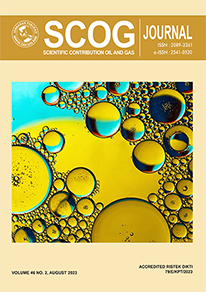Comparative Study of Plug and Abandonment Using Balanced Plug Cementing Method: Case Study of Well “NV-01†Field “NSâ€
DOI:
https://doi.org/10.29017/SCOG.46.2.1502Keywords:
fish, plug & abandonment, rig method, work programAbstract
The NOV-01 well is a directional well that has technical problems (fish), namely the stuck pipe problem and the problem of high land use operational costs. Based on the results of the evaluation of the economic and risk technical aspects, a plug & abandonment (P&A) was carried out for the NOV-01 well. The purpose of this research is to compare the 3 stages and 5 stages in P&A work and their influence on work program planning and budgeting. The research methodology is qualitative and quantitative. The NOV-01 well plug & abandonment activity is carried out by preparing a work program plan such as determining the depth interval of the well to be plugged, the volume of cement slurry & additives, as well as the rig method which all refer to the existing standards and regulations, namely SNI 13-6910-2002 and NORSOK D-010. The results of a comparative study on P&A planning at 3 stages required 279 sacks of cement and 450 sacks of cement at 5 stages with a density of 15.8 ppg. P&A on well NOV-01 uses the rig method with a capacity of 450 HP. For 3 stages it takes 9 days and 5 stages for 11 days. Comparison of estimated costs for P&A of NOV-01 well, namely 3 stages of IDR 6,062,977,890.31- and 5 stages of IDR 8,374,824,218.62-. Well NOV-01, P&A which is suitable is 5 stages because there is an overpressured zone so that the cement plug is isolated.
References
……, 2002, ‘Operasi Pemboran Darat dan Lepas Pantai yang Aman di Indonesia Pelaksanaan’, SNI 13-6910-2002, Badan Standarisasi Nasional.
Adam, N. J., Tommie, C., 1985, ‘Drilling Engineering- A Complete Well Planning Approach’, Research Associate, PennWell Publishing Company, Imprint Tulsa, Okla, 288-291.
Afrisca, C. C, 2020, ‘Evaluasi Rigless Plug & Abandonment: Sebuah Studi Kasus. Jurnal Nasional Pengelolaan Energi Migas’, 2, 09-2
Juventa, Ahmad, F. B., Nasri, M. Z., Fitriyanda, H., Ahmad, D. F. 2022), ‘Karakterisasi Reservoir Karbonat Menggunakan Inversi Impedansi Akustik Blok ‘X’, Formasi Tuban, Cekungan Jawa Timur’. Jurnal Geosaintek, 8, 173.180.
Kelm, C. H., Ronnie, R. F., 1999, ‘Well Abandonment-A “Best Practices†Approach Can Reduce Environmental Risk’, Paper Presented at the SPE Asia Pasific Oil and Gas Conference and Exhibition, Jakarta, Indonesia, 20-22 April, SPE 54344, 3-4.
Nelson,E. B., Dominique, G., 2006, ‘Well Cementing, Second Edition, Schlumberger, Sugar Land, Texas, ISBN-13:978-097885300-6., 513-514.
PT Pertamina EP., 2012, ‘Drilling Standart Operating Procedure BAB 37. Plug and Abandonment Well’.
Rabia, H., 2002, ‘Well Engineering & Construction’, Entrac Consulting Limited, London, 171-172.
Saroyo, B., 2014, ‘Desain Formulasi Semen Ringan (Light Weight Cement) untuk Mitigasi Kerusakan Formasi Akibat Penyemenan pada Sumur GMB’, Journal Lemigas, Pusat Penelitian dan Pengembangan Teknologi Minyak dan Gas Bumi, 48, 3, 119-132.
The Norwegian Oil Industry Association., 2012, ‘Well Integrity in Drilling and Well
Published
Issue
Section
License
Copyright (c) 2023 © Copyright by Authors. Published by LEMIGAS

This work is licensed under a Creative Commons Attribution 4.0 International License.
Authors are free to Share — copy and redistribute the material in any medium or format for any purpose, even commercially Adapt — remix, transform, and build upon the material for any purpose, even commercially.
The licensor cannot revoke these freedoms as long as you follow the license terms, under the following terms Attribution — You must give appropriate credit , provide a link to the license, and indicate if changes were made . You may do so in any reasonable manner, but not in any way that suggests the licensor endorses you or your use.
No additional restrictions — You may not apply legal terms or technological measures that legally restrict others from doing anything the license permits.














